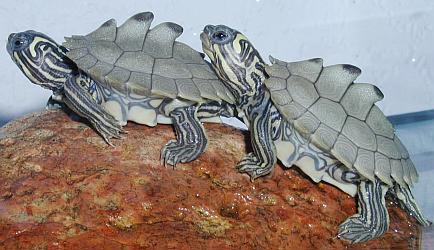Turtles and tortoises are the most popular of all reptilian pets – even “non-herpers” like them – and this is reflected by the many websites devoted to Chelonian-related matters. Following are some that I have found to be especially valuable. This list is by no means exhaustive…I’ll cover others in future articles.
The New York Turtle and Tortoise Society
I’ve worked with the dedicated folks at NYTTS for many years, and they have been kind enough to feature my articles on their  website. More important (infinitely more!) than my connection to NYTTS is their long standing relationship with legendary turtle biologist Peter Pritchard, who often speaks at the group’s day-long annual seminars. Rhom Whittaker, Mike Klemens, Roger Wood, Indraneil Das and numerous other notables have also participated in NYTTS sponsored programs.
website. More important (infinitely more!) than my connection to NYTTS is their long standing relationship with legendary turtle biologist Peter Pritchard, who often speaks at the group’s day-long annual seminars. Rhom Whittaker, Mike Klemens, Roger Wood, Indraneil Das and numerous other notables have also participated in NYTTS sponsored programs.
NYTTS provides quality husbandry information and also gets involved in the hands-on work upon which the survival of so many turtle species depends. They have long provided support to Southeast Asian students studying turtle biology here in the USA and to the fine work of the Wetlands Institute and have helped in large scale rescues of confiscated turtles.
NYTTS conservation and trade issues expert Alan Salzberg publishes Herp Digest, a wonderful resource and the only free electronic herp conservation and natural history newsletter.
Tortoise Trust
Tortoise Trust is one of the reptile-world’s most highly-respected sources of information on turtle and tortoise husbandry,  conservation and natural history. Noted author and herpetologist Andy Highfield directs the organization, which is utilized by professionals and hobbyists alike.
conservation and natural history. Noted author and herpetologist Andy Highfield directs the organization, which is utilized by professionals and hobbyists alike.
Tortoise Trust is unique among turtle interest groups in the range of activities it sponsors – courses, field trips, political action, research efforts – and in the numerous top notch publications it has generated (in addition to online material).
Turtles of the World
It’s difficult to believe that a resource of this caliber is available without charge on the inter net. An updated version of Ernst and Barbour’s classic book Turtles of the World, this publication provides detailed accounts and photos of the 288 species of turtle and tortoise described at the time of publication. A “must read” for serious turtle enthusiasts.
Turtle Homes
Operated by volunteers throughout the USA, the UK and Canada, and with connections to similar organizations in Asia and elsewhere, Turtle Homes members seek to place un-releasable turtles and tortoises with people or organizations that can properly tend to their husbandry and veterinary needs. They also post accurate care sheets, answer questions and direct site visitors to appropriate sources of information.
The California Turtle and Tortoise Club
The husbandry articles drawn from CTTC’s magazine, Tortuga Gazette, and posted on the group’s website, offer Chelonian enthusiasts some of the best information available on the inter net. The printed version of the Tortuga Gazette, published since 1965, is a well-written, invaluable resource to hobbyists and herpetologists alike.
The group is also actively involved in conservation efforts and supportive of turtle-friendly legislation, and offers site users a  number of ways to participate in such. In addition to dozens of informative articles, one may also find photographs and even recordings of tortoise vocalizations on this most useful web site.
number of ways to participate in such. In addition to dozens of informative articles, one may also find photographs and even recordings of tortoise vocalizations on this most useful web site.
 That Reptile Blog – Reptile, Amphibian and Exotic Pet Care and Information
That Reptile Blog – Reptile, Amphibian and Exotic Pet Care and Information

 Please see
Please see 
 Leopard, banded and fat-tailed geckos are classified in the gecko subfamily Eublepharinae, and differ from all other geckos in having movable eyelids. In fact, the genus name, Eublepharis, means “true eye lids”. The eyes of all other species in the family Gekkonidae are covered by a transparent cap, or spectacle, which is fused to the eyelids (like snakes, they cannot blink their eyes).
Leopard, banded and fat-tailed geckos are classified in the gecko subfamily Eublepharinae, and differ from all other geckos in having movable eyelids. In fact, the genus name, Eublepharis, means “true eye lids”. The eyes of all other species in the family Gekkonidae are covered by a transparent cap, or spectacle, which is fused to the eyelids (like snakes, they cannot blink their eyes). Red leg is sometimes cured or by refrigeration at 39 to 41°F for two weeks. This treatment, pioneered in laboratory colonies of leopard frogs, has also been successfully used with Mexican axolotls. It appears that the immune systems of some amphibians function more effectively at low temperatures, while Aeromonas bacteria does best under warmer conditions.
Red leg is sometimes cured or by refrigeration at 39 to 41°F for two weeks. This treatment, pioneered in laboratory colonies of leopard frogs, has also been successfully used with Mexican axolotls. It appears that the immune systems of some amphibians function more effectively at low temperatures, while Aeromonas bacteria does best under warmer conditions.